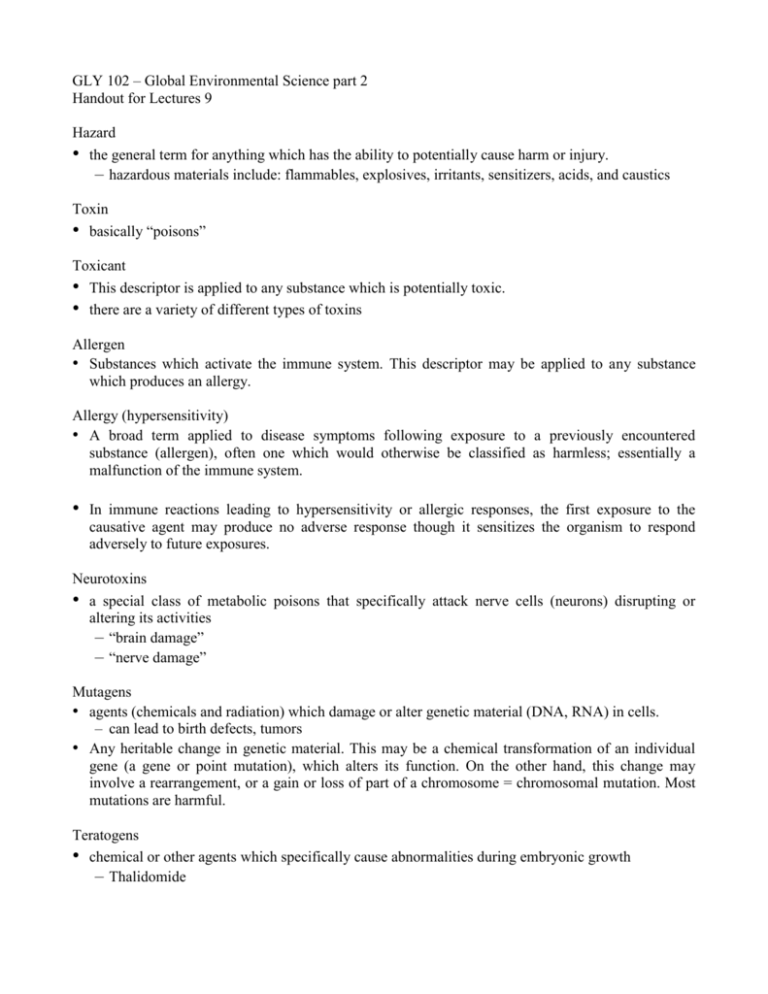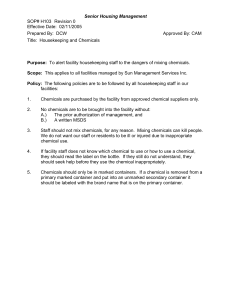GLY 102 – Global Environmental Science part 2
advertisement

GLY 102 – Global Environmental Science part 2 Handout for Lectures 9 Hazard • the general term for anything which has the ability to potentially cause harm or injury. – hazardous materials include: flammables, explosives, irritants, sensitizers, acids, and caustics Toxin • basically “poisons” Toxicant • This descriptor is applied to any substance which is potentially toxic. • there are a variety of different types of toxins Allergen • Substances which activate the immune system. This descriptor may be applied to any substance which produces an allergy. Allergy (hypersensitivity) • A broad term applied to disease symptoms following exposure to a previously encountered substance (allergen), often one which would otherwise be classified as harmless; essentially a malfunction of the immune system. • In immune reactions leading to hypersensitivity or allergic responses, the first exposure to the causative agent may produce no adverse response though it sensitizes the organism to respond adversely to future exposures. Neurotoxins • a special class of metabolic poisons that specifically attack nerve cells (neurons) disrupting or altering its activities – “brain damage” – “nerve damage” Mutagens • agents (chemicals and radiation) which damage or alter genetic material (DNA, RNA) in cells. – can lead to birth defects, tumors • Any heritable change in genetic material. This may be a chemical transformation of an individual gene (a gene or point mutation), which alters its function. On the other hand, this change may involve a rearrangement, or a gain or loss of part of a chromosome = chromosomal mutation. Most mutations are harmful. Teratogens • chemical or other agents which specifically cause abnormalities during embryonic growth – Thalidomide Carcinogens • substances that cause cancer - Cancer is a disease which results from the development of a malignant tumor and its spread into surrounding tissues. Bioaccumulation Definition: Toxicology is the basic science of poisons. –A poison is a substance that is capable of producing injury or death when ingested or absorbed. •However, as Paracelsus (1493-1541)has stated: –“All substances are poisons. The right dose differentiates a poison from a remedy ”. • • chemicals can be used safely if exposure of people or susceptible organisms is kept below defined tolerable limits, that is if handled with appropriate precautions. If no tolerable limit can be defined, zero exposure methods must be used. • Chemical Toxicology - the investigation of the effects of pharmaceutical chemicals on human health • Forensic Toxicology - concerned with the illegal use of chemicals • Environmental Toxicology - covers the effects of chemicals in the environment on organisms Exposure • is a function of the amount (or concentration) of the chemical involved and the time of its interaction with people or organisms at risk. Skin (dermal) absorption • chemicals can penetrate healthy intact skin • Amongst the chemicals that are absorbed through the skin are aniline, hydrogen cyanide, some steroid hormones, organic mercury compounds, nitrobenzene, organophosphate compounds and phenol. • Some chemicals, such as phenol, can be lethal if absorbed for a sufficient time from a fairly small area (a few square centimeters) of skin. Inhalation • Gases and vapors are easily inhaled • Inhalation of particles depends upon their size and shape. The smaller the particle, the further into the respiratory tract it can go. • Dusts with an effective aerodynamic diameter of between 0.5 and 10 micrometers can persist in the alveoli and respiratory bronchioles after deposition there. • Dusts of larger diameter either do not penetrate the lungs or lodge further up in the bronchioles and bronchi where cilia (the clearance mechanism) can return them to the pharynx and from there to the esophagus. • From the esophagus dusts are excreted through the gut in the normal way: it is possible that particles entering the gut in this way may cause poisoning as though they had been ingested in the food. • Physical irritation by dust particles or fibers can cause very serious adverse health effects but most effects depend upon the solids being dissolved. • Special consideration should be given to asbestos fibers which may lodge in the lung and cause fibrosis and cancer even though they are insoluble and therefore not classical toxicants: similar care should also be taken with manmade mineral fibers. • Some insoluble particles such as coal dust and silica dust will readily cause fibrosis of the lung. Others, such as asbestos, may or may not cause fibrosis depending on the exposure conditions. Ingestion • Airborne particles breathed through the mouth or cleared by the cilia of the lungs will be ingested. Otherwise, ingestion of potentially toxic substances in the work, domestic, or natural environment is likely to be “accidental” In deciding on what constitutes a tolerable exposure, the chief problem is often in deciding what constitutes an injury or adverse effect. • • • • • An adverse effect is defined as an an abnormal, undesirable, or harmful effect to an organism, indicated by some result such as mortality, altered food consumption, altered body and organ weights, altered enzyme levels, or visible pathological change. For very highly toxic chemicals, tolerable exposure may be close to zero. Reversible changes may also be harmful but they may often be essentially harmless. An effect which is not harmful is usually reversed when exposure to the potentially toxic chemical ceases. Adaptation of the exposed organism may occur so that it can live normally in spite of an irreversible effect. The amount of exposure to a chemical required to produce injury varies over a very wide range depending on the chemical and the form in which it occurs. Synergistic effect • A synergistic effect is the any effect of two chemicals acting together which is greater than the simple sum of their effects when acting alone: such chemicals are said to show synergism. Measurements of toxicity • Median lethal dose (LD50):-The statistically derived single dose of a chemical that can be expected to cause death in 50% of a given population of organisms under a defined set of experimental conditions. • Where LD50 values are quoted for human beings, they are derived by extrapolation from studies with mammals or from observations following accidental or suicidal exposures. Dose/Response Relationship • Dose - the amount of a chemical/substance that is administered to an experimental animal • Dosage - dose specified with relation to a characteristic of the animal like weight or skin area • Response - specific adverse health effects observed – ex. death, tumor growth, organ impairment – there may actually be several responses but only one is examined at a time • Use this data to create a dose/response curve Curve Forms • Linear curve no threshold – Stochastic response • Linear curve w/threshold – Deterministic response • Non-Linear curve w/ or w/o threshold Epidemiology • the study of the occurrence of adverse health effects in humans • search for patterns of exposure to chemicals, radiation, or even patterns of diet • relate these patterns to to incidence of disease, damage or impairment • Concerned with GROUPS not individuals









